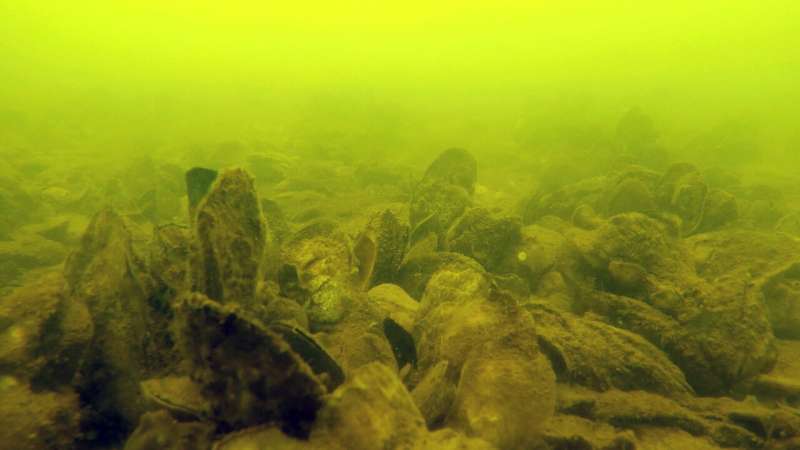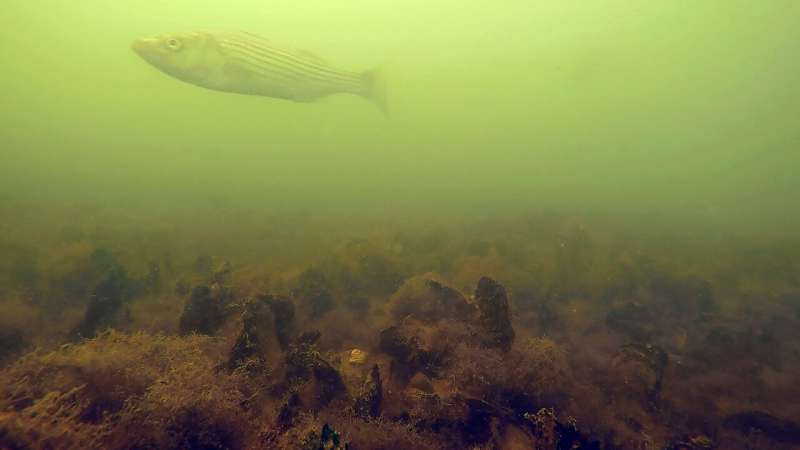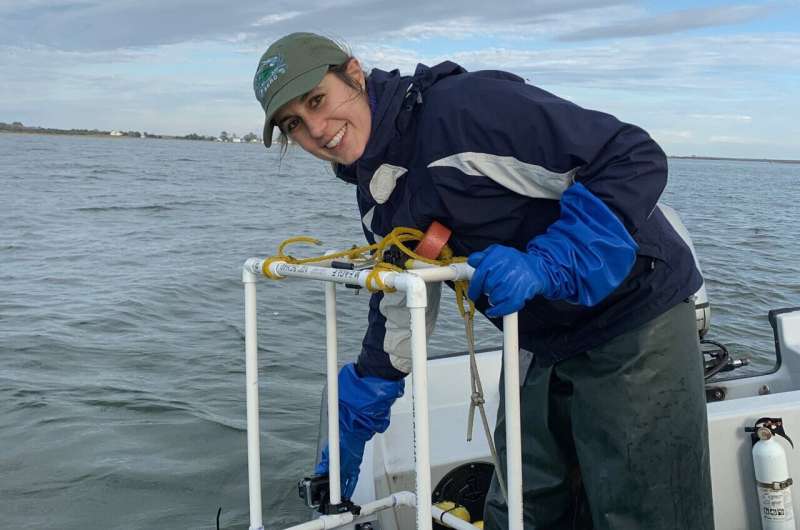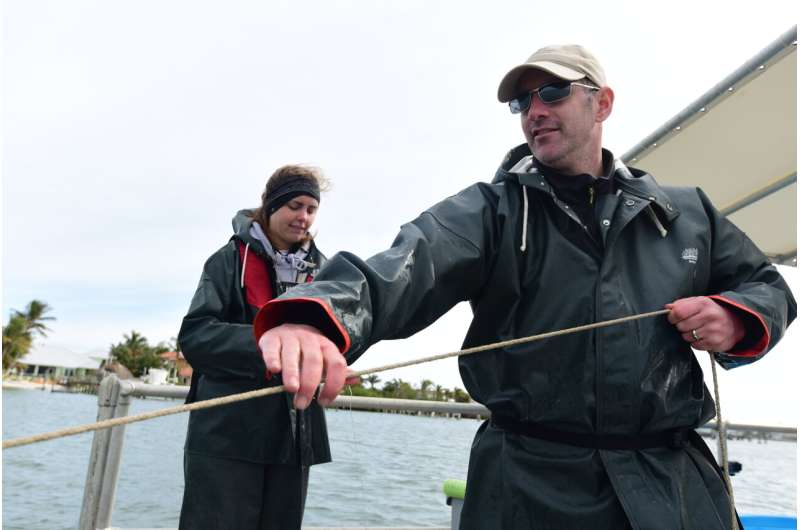
A restored oyster reef in a sanctuary on the James River in Maryland. Credit: Fisheries Conservation Lab, Smithsonian Environmental Research Center
In the campaign to restore the Chesapeake Bay, oyster sanctuaries are among the most controversial strategies. But new research suggests that these no-take zones work, and not just for oysters.
In a new study published July 4 in Marine Ecology Advances SeriesSmithsonian biologists have found that oyster sanctuaries contain more abundant populations of oysters and other animal life, and the presence of two common parasites doesn’t prevent that.
Oysters are the backbone of the Chesapeake Bay. In addition to pumping millions of dollars into the regional economy each year, they also provide vital habitat and filter feeders that clean the water. But their populations have declined to about 1 percent of historical levels. Disease, overfishing, habitat loss and pollution have reduced their numbers.
Over the past two decades, Maryland and Virginia have worked to restore their oysters by creating large networks of sanctuaries where oysters are protected from harvest. That has led to a rebound in oyster growth, habitat quality and biodiversity within the sanctuaries, the new study found.
“Sanctuary programs appear to be working and facilitating the regrowth of oyster reefs after so many decades of overexploitation,” said lead author Zofia Anchondo, who conducted the research as part of her graduate fellowship at the Smithsonian Environmental Research Center and the University of North Carolina at Chapel Hill.
But at the same time, the resurgence of marine life has been accompanied by an increase in oyster parasites. The study focused on two parasites in particular: the boring sponge and the mud worm.
Boring sponges bore holes into oyster shells for shelter. Blister worms dig U-shaped burrows inside the shells. The presence of either can make oysters unsightly or even unmarketable. Both parasites are thought to be likely native to the bay, and neither is dangerous to humans. For this study, the researchers did not look at dermo or MSX, two nonnative parasites responsible for some of the worst oyster accidents, although they did collect data for a follow-up study.
Parasitism is the most common mode of life on Earth, so the presence of a parasite is not necessarily a sign that the environment is out of order, the authors point out.
“Parasites have been overlooked as an important component of biodiversity,” said Allison Tracy, a co-author of the study at the University of Maryland, Baltimore County and the University of Maryland School of Medicine. “But they are a natural part of ecosystems… The natural functioning of ecosystems depends on the effects of parasites.”

A striped bass, also known as a redfish, swims over an oyster reef in the Chesapeake Bay. Credit: Fisheries Conservation Lab, Smithsonian Environmental Research Center
“They don’t prevent high oyster densities,” said Matt Ogburn, co-author and senior scientist at the Smithsonian Environmental Research Center. They might even be beneficial for the long-term evolution of oysters, Ogburn added, though that question requires further research. “Restoring oyster reefs is likely to help the oyster population become more resilient to the parasites that are present now, compared to what would be possible if everything was harvested all the time.”
The new study focused on three Chesapeake tributaries: the Choptank River, the Great Wicomico River and the James River. Each had its own oyster sanctuary and a comparison harvest area where fishermen could freely catch oysters.
The scientists used footage from underwater GoPro cameras to assign each reef a habitat “score” (from one to four, based on the percentage of oyster cover and vertical structure). The GoPro videos also allowed them to record other animals visiting the oyster reefs. Working under state auspices, the divers then collected some of the oysters from each reef to estimate oyster density and look for parasites.
Overall, oysters are doing better in sanctuaries. All three tributaries had higher densities of legal-size oysters in their sanctuaries than in their harvest sites. In two tributaries, the James and Great Wicomico rivers, oysters of all sizes, including juveniles and baby oysters, were more abundant in sanctuaries.

Allison Tracy deploys a camera with GoPros to study oyster reefs underwater. Credit: Fisheries Conservation Lab, Smithsonian Environmental Research Center
The sanctuaries also scored higher on habitat quality, and the videos showed many underwater animals enjoying them. Blue crabs, rockfish, and summer flounder were just a few of the species that flocked to the sanctuary reefs. In the James and Great Wicomico rivers, researchers estimated that the sanctuaries supported 10 times more animals and nearly double the number of species than the harvest reefs. The only exception was the Choptank River, where animal life was low in both the sanctuary and the harvest sites.
However, as the oysters thrived, both parasites multiplied. More than half of the oysters at all six sites (sanctuary and harvest site) had holes indicative of a piercing sponge attack. However, the piercing sponge was more prevalent in the sanctuaries than in the harvest sites in two of the three tributaries. Bloodworms were much less abundant (infecting 2–10% of oysters) but still more numerous in the sanctuaries than in the harvest sites in two of the tributaries.
Neither parasite is dangerous to humans, the authors point out. Both parasites only infect oyster shells, not the tissues of the oysters that humans eat.

Matt Ogburn on a tagging expedition. Credit: Jay Fleming/Smithsonian Institution
“It’s more of a problem for the fishermen because it can make the shells less attractive,” Tracy said. “It can decrease the value of the oyster for the half-shell market. But it has no effect on our health.”
In the unlikely event that a person accidentally swallowed one of these parasites along with a raw oyster, Tracy said, it would simply pass through their system without impact: “There’s no shell for it to find to drill into your stomach. So basically, it wouldn’t be interested in it.”
More information:
ZB Anchondo et al., Reefs in no-take reserves harbor more oysters, macroparasites, and macrofauna than reefs harvested across an estuarine salinity gradient, Marine Ecology Advances Series (2024). DOI: 10.3354/meps14615
Quote:Restored oyster sanctuaries host more marine life despite parasites, biologists find (2024, July 8) retrieved July 9, 2024 from https://phys.org/news/2024-07-oyster-sanctuaries-host-marine-life.html
This document is subject to copyright. Apart from any fair dealing for the purpose of private study or research, no part may be reproduced without written permission. The content is provided for informational purposes only.